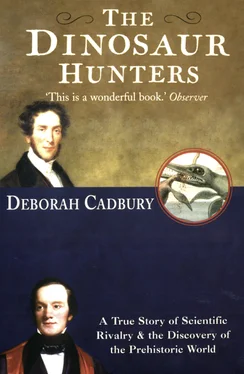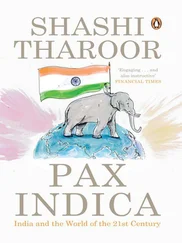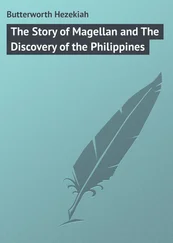Although he could not name the creatures or have any clear conception of the kind of beast he was describing, this was the first attempted scientific description of dinosaur remains correctly identified as giant lizards. It was a vivid snapshot of a wondrous unknown past. ‘We know not the millionth part of the wonders of this beautiful world,’ he wrote. ‘It is the pleasing task of the geological inquirer … to discover order and intelligence in scenes of apparent wildness and confusion … to recognise a series of awful but necessary operations by which the harmony, beauty and integrity of the universe are maintained … which must be regarded as wise provisions of the Supreme Cause.’
As he proudly received the first printed copy at the beginning of May 1822, he had high hopes that this would prove a turning-point in his career. ‘I am resolved to make every possible effort to obtain that rank in society to which I feel I am entitled both by my education and my profession,’ he wrote in his journal. Surely, fired by these strange findings, some rich patron would step forward; his endless round of medical duties that took up so much of his time would, perhaps, soon be a thing of the past? At the very least, he hoped that his labours would be well received by the prestigious London societies: the Royal Society and the Geological Society.
Soon after the publication of his book, Mantell took some of his Sussex fossils to a meeting of the Geological Society in Covent Garden. The worn teeth of the giant herbivore were carefully wrapped in cloth. It was a long and tiring journey to London by chaise, stopping several times to change the horses, before he found his way to the House of the Geological Society at 20 Bedford Street. The Reverend William Buckland, now the Vice-President of the Society, had come down from Oxford with his friend the Reverend Conybeare. William Clift, Conservator of the Hunterian Museum of the Royal College of Surgeons, was also present.
Mantell’s diary and his subsequent accounts reveal that after the business of the meeting was completed, he showed these experts some of the worn, brown teeth from his unknown herbivorous animal. ‘I was discouraged by the remark that the teeth were of no particular interest,’ he wrote. The experts did not agree with Mantell that the ‘tooth’ belonged to an ancient herbivorous lizard. Far from such an exotic and fanciful verdict, they claimed: ‘There is little doubt the teeth belonged either to some large fish, allied to “Anarhic[h]as lupus” or wolf-fish, the crowns of whose incisors are of a prismatic form, or were mammalian teeth obtained from a diluvial [recent] deposit.’
Thus the combined wisdom of these august members of the Geological Society was that the tooth on which Mantell had pinned all his hopes belonged to nothing more exotic than a recent mammal such as a rhinoceros or an oversized fish! Mantell felt their dismissive lack of interest keenly. How could anybody build a reputation on a large fish? There was only one person there who dissented from the expert verdict – William Hyde Wollaston – and he happened to be the only person present who was not a geologist.
The scepticism of the experts at the Society stemmed from the fact that they did not accept Mantell’s classification of the strata of the Weald as Secondary rock. His conclusion that he had found a giant herbivorous lizard could be wrong if his interpretation of the Tilgate beds as ancient Secondary rock was incorrect. Numerous mammalian remains had been found in the more recent Tertiary rocks which lay above the Secondary strata: mammoths, elephants, rhinoceros and hippopotamus. If the Weald rocks in Sussex were Tertiary, then the giant fossils within them, far from belonging to some improbable species of herbivorous reptile, were much more likely to be from any of these large mammals. To persuade the experts that he had indeed found an ancient reptile, he had first of all to prove beyond doubt that the Tilgate beds were Secondary rock.
The eminent members pored over the details of Mantell’s findings and tried to fathom whether the limestone and sandstone of the Tilgate Forest were part of the ‘Purbeck’ formation, or ‘Ferruginous sand’, ‘Greensand’, ‘Iron-sand’ or ‘Hastings sand’. Their task was made all the harder since the names for the Sussex strata were not yet standardised and everyone was using different terms for the various layers, adding to the bewilderment. For Mantell, with each learned utterance from the experts the years of painstaking work were falling away, the exotic lizards of mythical proportions fast fading into nothing more than a figment of his imagination. He was just a country doctor, after all.
There was good reason to be confused when trying to place the strata of the Tilgate Forest into the geological sequence. Unlike the Stonesfield rock near Oxford where the fossils were found deeply buried, the rock at Whiteman’s Green in the Weald was inexplicably close to the surface. Was this, as Mantell claimed, a protrusion of older, Secondary rocks? Or was it a recent deposit, perhaps of Tertiary or even younger alluvial rocks, as Buckland thought. In Fossils of the South Downs Mantell made no attempt to conceal his perplexity about the exact position of the strata in which he had found his giant reptiles. Although he had correctly identified the Tilgate Beds as Secondary, he did admit that the precise ‘geological position of these beds [within the Secondary series] is involved in much obscurity and cannot at present be satisfactorily determined’.
Faced with the disbelief of the Geological Society, shortly after this meeting Mantell made yet another survey of the Sussex rocks, this time with his friend Charles Lyell. Riding west from the Tilgate Forest, Lyell and Mantell searched for quarries that contained strata and fossils that matched those found at Whiteman’s Green. They were hoping to find a site where the different layers of rock were clearly exposed in the geological sequence, so they could prove beyond doubt the exact position of the Tilgate Beds within the Secondary series of rocks. If they could convince the experts that the Tilgate rock was Secondary, then surely no one would doubt that Mantell had indeed found an ancient giant lizard?
To Mantell’s delight, they uncovered similar organic remains – bones, teeth and ‘numerous vegetables allied to the Cycas’ – in the sandstone cliffs of Hastings, Rye and Winchelsea. Even better, in a quarry near Rye they found the strata laid bare. Sandstone and limestone matching the Tilgate beds were embedded in the Secondary rock known as Iron-sand.
After this expedition, on 1 June 1822 Mantell wrote triumphantly to Dr William Fitton, the Secretary of the Geological Society: ‘I think we may fairly conclude that the sandstone of Rye, Winchelsea, Hastings, Tilgate Forest and Horsham are but different portions of the same series of deposits belonging to the “Iron-sand” formation.’ Mantell was now completely satisfied that the limestone and sandstone in which he had found the giant bones in the Weald could be placed in the Secondary series, well below the chalk formations. Consequently, in his letter to the Geological Society he went even further. In defiance of the experts such as Buckland, he restated his own interpretation of the animal remains that he had found. The large herbivorous teeth were now clearly identified as ‘Teeth of an unknown Herbivorous Reptile, differing from any hitherto discovered either in a recent or fossil state’. In addition, he confirmed that he had the teeth and bones of a lizard resembling those found at Stonesfield, and ‘Teeth and bones of crocodiles and other Saurian [lizard] animals of an enormous magnitude’. From the evidence of this letter the amateur Gideon Mantell was in no doubt that his beguiling view of a buried ancient world inhabited by several different species of giant reptiles – herbivores and carnivores – was an accurate one.
Читать дальше












